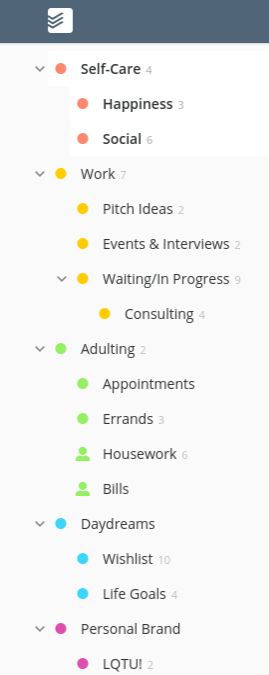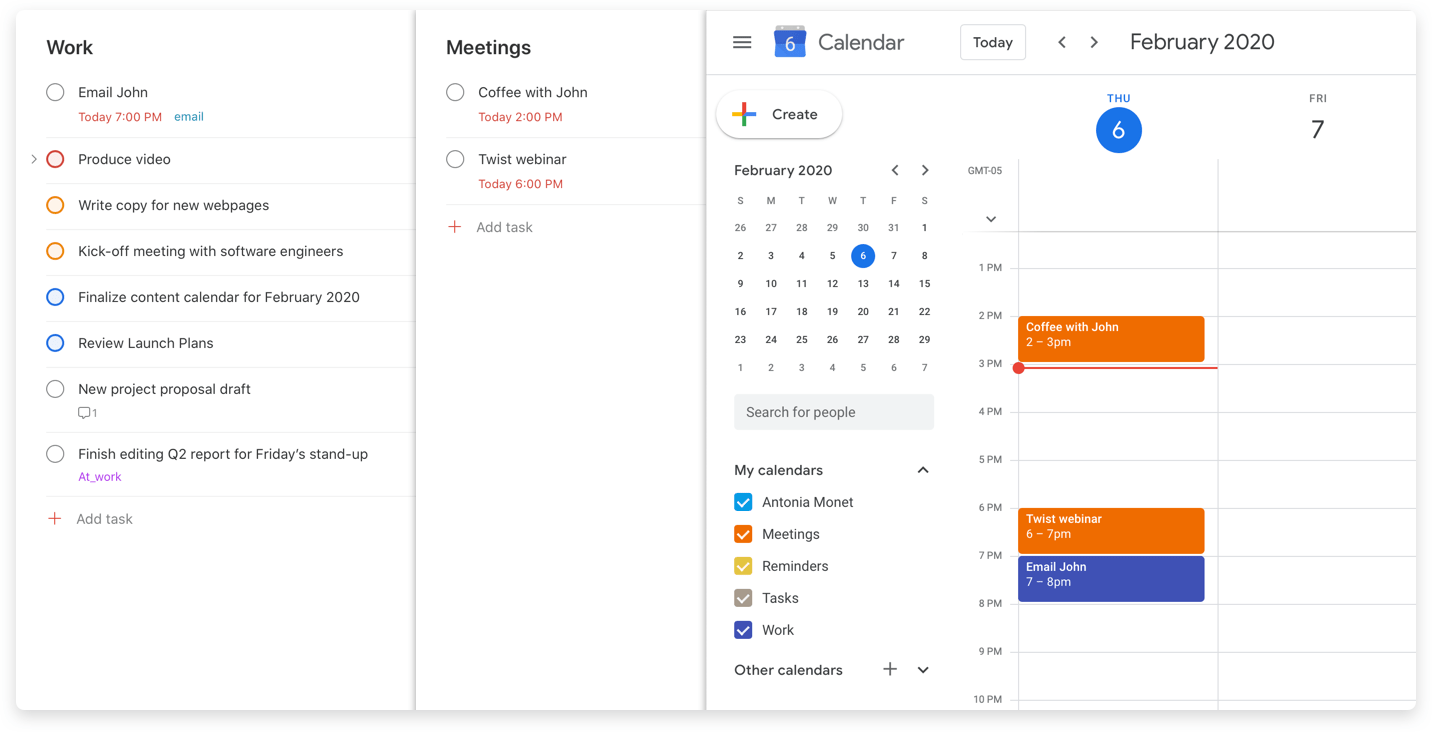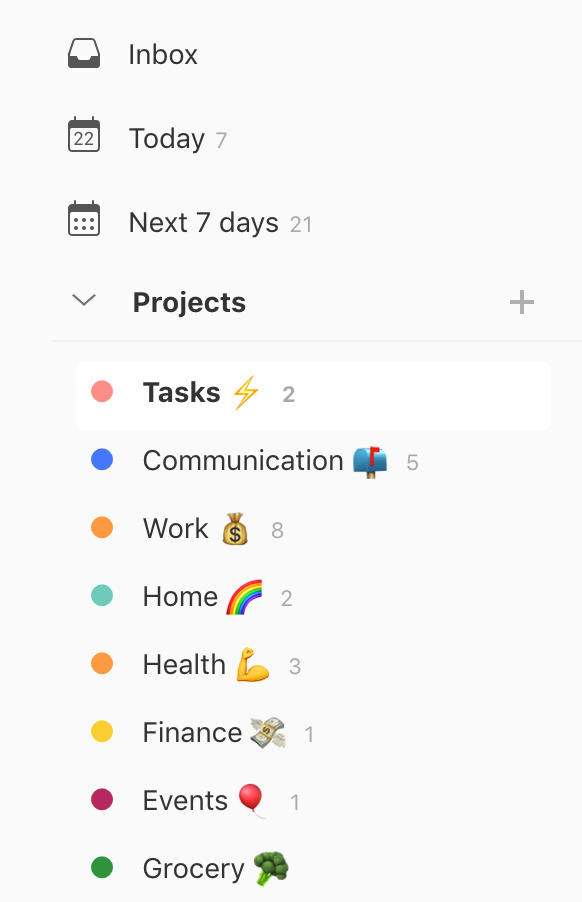If you use your bullet journal purely for reminders or to-do lists, Todoist might be the app for you. It is a much more streamlined app than the others on this list, and it concentrates on lists. While it lacks the range of features of some of the apps here, it dives much deeper into the functions that it features. You can also use various Note-taking apps which include OneNote, Google Keep, Evernote, Notion, Simplenote, Todoist, Samsung Notes, etc. And customize your bullet journal according to your.
For a few years now, I’ve been a staunch Bullet Journal advocate. Yes I’ve tried Things 3, OmniFocus, Todoist, and many other options, but I kept coming back to the simplicity of writing my tasks down on paper and leaving a notebook on my desk. After a few months, every other system simply turned into something I didn’t check regularly, which meant it was a lump of tasks that had no meaning anymore.

I came to the realization that, by default, a Bullet Journal defaults to no while other digital systems default to yes. Digital systems drag any overdue tasks forward, where your Bullet Journal makes you do work to move tasks forward. If you think a task is too much work to move forward, you’re telling yourself that it’s not important and should simply stay undone.

It’s also far too easy with most task managers to schedule 27 tasks on some day in the future. You look at your task manager on that day and despair because you know not everything will be finished.
Enter NotePlan 2, my favorite digital Bullet Journal application. NotePlan 2 combines your tasks and your calendar, so if you love timeblocking like Mike and I do, you’re going to be excited about this application. It does all this in a system that any Bullet Journaller will recognize.
Our Must-Have, Most Used Productivity Apps
We spend an inordinate amount of time sorting through hundreds of apps to find the very best. We put together a short list of our must-have, most-used apps for increasing productivity.

Why Use NotePlan 2 as a Bullet Journal?
At first glance, NotePlan 2 centers around a daily note just like a Bullet Journal. Here you can write down tasks or notes of the day. Tasks can be organized with headings and you can use indentation for sub-tasks or any other information you need for your task.
NotePlan 2 also offers a place to store other notes about anything. Say you’re in a meeting and want to take notes — just open a new note and start typing away. If a point in that note needs a due date, you can easily turn it into a task and then assign a due date to it. This task will now show up on the day alongside your daily note. I view these notes as my Collections in the Bullet Journal Method.
NotePlan allows you to use the standard bullet journal notation of * to mark something as a task, though it will turn it into a circle to use as a checkbox. It also allows you to push a task to a different day and shows that by changing your bullet to a clock icon. If you want to migrate a note to a Collection, that’s a copy/paste operation and it won’t show you the Bullet Journal standard < to signify that a task has moved to a collection.

For any tasks that you want to repeat, you can do this on macOS by clicking the three bars beside your task. Then, choose the repeat interval from the dialog. This same functionality can be accessed on your iPad or iPhone via the clock icon in the bottom left corner of the screen. Screen record mac os mojave.
To add a layer of organization, NotePlan 2 offers a tagging system by using the pound symbol to signify a #tag. This can let you tag an individual note, or some items in a daily note and then collect them with a filter so you can see it all in one spot. I use this to tag tasks in a specific day for a client so that I can easily backtrack to see what I worked on in a given month.
NotePlan also includes the @ symbol, which it intends for mentioning people. You can use this just like a tag and collect every time you’ve mentioned a person in a task so you can see everything that pertains to them. You could also use this as a Context notation so you can collect all your @errands in one spot and do them when you’re out.
The application also offers internal linking between notes. That lets you take notes on a specific meeting, and then add your meeting notes to a client note so you can track it down later by going to your client note. I use it when I have a list of approved writing topics for a client. When I start an item, I link to the individual note with all the tasks on it for that specific piece. Once I’ve finished a piece, I can resolve the main item in the content note.
If you need to track your tasks to a specific time so that you can be reminded of them, NotePlan integrates with Reminders. I use this for a daily reminder to give one of my daughter’s a pill at 3pm. I can resolve this task either in Reminders or in NotePlan on any device I happen to be near, and it will be resolved everywhere.
Another excellent feature that NotePlan offers is a strong saved search system. You can search your Notes, Calendar entries, Reminders, or Events and then filter them by time or status. You can save these searches and they will show up across your devices for easy access. The only drawback to this system is that you can’t change a saved search once it’s been created. You have to delete it and try again with adjusted search parameters. I’ve found it’s better to simply run the filter until it’s right and then save the settings once it works like you expect.
Why I Prefer NotePlan 2
There are a few reasons that NotePlan 2 stands out to me above other task managers. First, I love the calendar integration. I think that booking your tasks into a day without looking at your calendar for the day almost always leaves you with way too much to get done given the time you have. NotePlan 2 gives you a constant view of any appointments you have alongside your tasks in a way that other task managers don’t do as well.
I also love how you can include notes on the day alongside your tasks as a running journal for the day. For years, I’ve kept my Bullet Journal open on my desk and written down what happens during the day. I’ve now moved most of this process to NotePlan 2 to capture things from any device that happens to be near.
I also like that NotePlan 2 that uses Markdown files that are stored on your computer. Nothing is stopping the sufficiently nerdy from figuring out how to read the files and then using any other system to use the data. This means that migrating away or creating a backup of your notes is a simple task.
Finally, there is a very active Reddit community for NotePlan 2. You won’t find many YouTube videos about it, but you can get help in short order on Reddit, and the developer of the application is there regularly to talk with users.
Shortcomings of NotePlan 2
For all that I love about NotePlan 2, it’s not all unicorns and sprinkles. If you’re creating a tasks that needs to repeat a lot, then it’s fairly slow at writing all the Markdown files for anything over 100 repeat cycles. It works on every platform, but you end up waiting longer if you’re using your iPad or iPhone to create those types of repeating tasks.
Bullet Journal Vs Todoist
It’s also best to delete repeating tasks if you want to change something about them, and you should do this from macOS. macOS is the only platform that I’ve seen the option to delete all future instances of a task. On my iPad or iPhone, it simply deletes a single instance, leaving me to manually clean up all the future tasks as well.
One final thing I wish NotePlan 2 had was a better way to change between notes. Currently, you have to search and find them in the notes view. That means a bunch of clicking to change views and get to what you want. Luckily, there is light at the end of the tunnel as demonstrated by the developer in a NotePlan 3 feature peek. I’m very much looking forward to that quick search and entry panel.
Overall, if you’re looking for an application that emulates the Bullet Journal system to organize your notes, calendar, and tasks, then NotePlan 2 is an excellent option. It has feature parity across devices with few real limitations and has been a joy to use over the last number of months.
NotePlan 2 is available via SetApp or for a $29.99 in-app purchase on the App Store. The iPadOS and iOS version are available as a bundle for $14.99 from the App Store.
Our Must-Have, Most Used Productivity Apps
We spend an inordinate amount of time sorting through hundreds of apps to find the very best. We put together a short list of our must-have, most-used apps for increasing productivity.
First, let me apologize if you are here to read about hiking and climbing, and found this strange blog. Second I apologize if you are lost in the hiking / climbing trip report’s looking for some thoughts on Bullet Journaling using Todoist. This is the only access I have to the internet and I wanted to get a couple idea’s out there that have been of benefit to me regarding bullet journaling and Todoist.
I’m going to assume you already know a little about Bullet Journaling and perhaps a little or a lot about Todoist. I don’t want to take a lot of time, but let me give a brief history of how I arrived at this point in time. I am by nature a “productivity student”. Ever since I went to college in the late 70’s and needed money to live and eat. Upon writing my father and asking for some cash, he sent me a book entitled “You can, if you think you can”. I’m pretty sure I sold the first book without reading it, but soon fell in love with the “self help” concept. Granted in the 70’s and 80’s it was more vague concepts than practical. Nothing along the lines of - here’s how you do it step by step - but it was a start.
I was soon familiar with the Franklin Planner, but favored Stephen Coveys philosophy and methods. First Things First is still one of my favorite books. I soon grew tired of the weekly analysis from the top down approach of Mission to planning the week. I had trouble remembering to take out the garbage on Thursday and Mr. Covey had me planning to take over the world every week. Next came David Allen, which stood in relief to Mr. Covey’s top down approach with Mr. Allen’s bottom up approach. Clear the runway (small daily items) and give yourself the bandwidth to move up to higher altitudes. This really resonated with me and I have been relatively successful in keeping Getting Things Done as my primary methodology at work.
Work has pretty solid, defined edges and working with an astute Branch Manager, things move along very smoothly using Projects, next actions and the other important Context items of Mr. Allen’s approach. Where things always got messy for me is having the same defined edges in my personal life. Keeping a context based list of @calls, @home, @errand for personal items seems to last only a few days or weeks before the wheels would come off the wagon. I tried cards, mind mapping, copy - paste, and finally Todoist. Todoist seemed to give me the best Band-Aid of keeping track of items, with the added bonus of being accessible from work. It was still just a Band-Aid, but Todoist allowed the process to move forward with it’s sync between different devices and being able to bounce between work and home computers. The one thing that constantly plagued me about the Getting Things Done methodology was being able to capture everything and I mean everything so that it was out of my brain and into a trusted system.
A few months ago, as has been common over the past 15 year, an idea I wasn’t familiar with caught my eye. A book outlining how to start a Bullet Journal appeared in my Kindle Unlimited. I downloaded the book, scanned read it and quickly returned it after seeing all the fancy pages of paper and the artistic script and coloring for each day. But something stuck, this weird concept of logs of tasks, symbols and events, the idea of capturing notes in short phrases, almost like shorthand and using that to “track the past, organize the present, and plan for the future” - Ryder Carroll.
I downloaded and skimmed a few more books, but I couldn’t bring myself to go back to paper. Just couldn’t do it. I Googled using Todoist for bullet journaling and found some strange hybrid ideas of people using a combination of paper and Todoist (some even written by Todoist employees). But I could find nothing outlining a bullet journal on Todoist. I looked seriously at Ryder Carroll’s new book on The Bullet Journal Method: Track the Past, Order the Present, Design the Future but couldn’t bring myself to pay the price of the book especially after reading some of the reviews. I am after all a member of the cheaper Amazon Unlimited group. I finally downloaded The Minimalist Bullet Journal Method by April Wills. It’s small, easy to understand, free with my unlimited subscription, and although lacking in illustrations gave a straight forward method of how to create a bullet journal.
I was bound and determined to use an electronic platform and Todoist was still my preferred application. Somewhere during chapter 4 and “The Step-by-Step Guide to Bullet Journaling” it dawned on me that using Todoist - I didn’t need an Index. Todoist already provides an index on the left hand side of the screen. Setting up the Future Log was as easy as adding a project entitled “Future Log” and adding additional indented monthly logs underneath - April 2019, May 2019 etc. A separate daily log was created with ease, and adding tomorrows date - 2019-04-25 as a new project indented under daily log kept the index nice and clean. I played around the dots “.” and dashes “-” using Todoist until I realized that a simple flag for @Task, @notes and @events allow me to tag items much faster than trying to type in the “…” or the “—-” and actually have them large enough to make sense in the electronic format. I spent about an hour transitioning all my current meetings, to the Future Log and their respective months by utilizing the shortcut # hashtag followed by the name of the monthly log. I then simply needed to practice capturing information as it flowed into my day making the appropriate @task or @note. Schedule an appointment? No problem @event followed with the date and time. Some Bonus features? Todoist links with my Google Calendar so I don’t need to update more than one application.
Bullet Journal Todoist
I’m going to end the written blog part here for those who are familiar with both Bullet Journal and Todoist, I’m going to come back and create a part 2 with exactly how I set Todoist up and how I am currently using it to collect things in my life. The first day I captured 10 items, the second 32. The third day I managed to clean out my email, inbox, take a nap, read the Wall Street Journal and capture 65 items. And I haven’t even begun to talk about forwarding emails direct to Todoist inbox, drag and drop pdf’s, or starting a collection of inspiring memes. Good luck and we’ll break it down further with part 2 for Bullet Journaling using Todoist.
